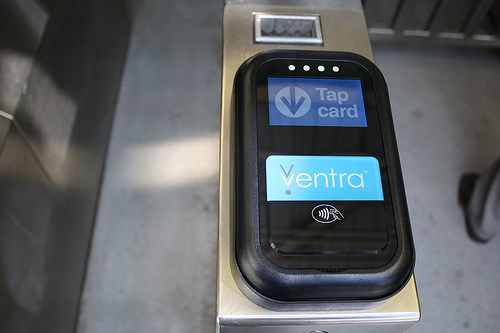| « Ventra Venting on "Chicago Tonight" | When The City That Works Stops Working » |
Transportation Mon Dec 09 2013
Can Metra Successfully Switch to Ventra? Possible, but not Probable

Image courtesy of CTABy now, the Chicago Transit Authority's problems with Ventra have been as frequent as they've been frustrating.
CTA President Forrest Claypool insists the system's glitches and errors have been reduced. Yet the agency will continue to accept the old magnetic stripe and Chicago cards while withholding payment to Ventra's vendor, Cubic Transportation Systems, until certain performance benchmarks are met.
However, Ventra's reliability is more than just a Chicago concern. On July 7, 2011, Illinois Governor Pat Quinn signed into law a legal mandate for the CTA, Pace, and Metra transit systems to be united under an open fare payment system (one that allows payment through bank-issued or universal cards) by January 1, 2015. In turn, the CTA and Pace have both adopted the legally-qualifying Ventra system.
That leaves the Metra -- a train system that spans 11 individual lines across Northeastern Illinois and part of Wisconsin -- a little over a year to comply with state law.
On paper, it's possible for the expansive commuter rail system to make a smooth transition to Ventra over the next 12 months. But with the ongoing issues plaguing the CTA, and Metra's own recent troubles, there's good reason to question whether it's probable.
Currently, Metra plans to transition to Ventra sometime around August 2014, with a trial period involving conductors with handheld Ventra readers. One hurdle is the fact that the three systems have differing pay structures. CTA and Pace charge a flat flare, whereas Metra is pay-per-distance. But Cubic has dealt with this potential non-starter before.
As the Tribune's Richard Worloski noted over two years ago, the Cubic-designed Clipper card has managed to unite seven independently functioning transit systems across the San Francisco Bay Area under one payment system. These include transit agencies ranging from the distance-based Bay Area Rapid Transit (BART) rail line to the single-fare Santa Clara Valley Transportation Authority (VTA) light rail, paratransit, and buses.
Bay Area riders have other payment options for the individual systems and the Clipper has had its share of problems. Regardless, the Clipper still demonstrates that Cubic has the means and know-how to calculate fare payments for a system like Metra alongside CTA and Pace rides.
But the question remains as to how exactly Metra is going to implement the card.
In contrast to Ventra's digital capabilities, Metra's fare payment system is built on employees manually issuing and punching individual paper tickets. In addition to the aforementioned pilot program with handheld Ventra readers, the agency will also launch a pilot program for using mobile phones as "virtual tickets" and look for ways to avoid the kind of glitches from the CTA-Ventra rollout.
However, this may not solve the problem. As Metra spokesperson Michael Gillis explained to the Sun-Times' Rosalind Rossi, "You can't just tap a Ventra card on a reader because it won't know where [a Metra rider] got on and off... that information has to be programmed.''
Tapping a card on a reader when getting on and off a bus or train is how the Cubic-designed universal smart card systems currently rolling out in Vancouver and Sydney will operate. Eventually, the Vancouver Compass and Sydney Opal will replace their cities' respective use of paper tickets for transit fare payment.
Another possible payment plan to calculate distance traveled would be tapping a card to enter and exit a station turnstile. This is how the Clipper-compatible BART works across San Francisco, Oakland and surrounding towns. But as the Dec. 4 Tribune article noted, Metra chief financial officer Tom Farmer told the Regional Transportation Authority last Wednesday that buying turnstiles for 241 stations would cost "hundreds of millions of dollars."
Furthermore, Ventra has already complicated at least one Metra policy -- along with the state's overall goal for seamless regional public transit. Users of its unlimited monthly CTA/Pace ride Link-Up and BusPlus cards have been informed of new rules affecting how the passes will work with Ventra readers. In a telling sign that there are technical glitches yet to be fully worked out, Link-Up and BusPlus users must manually show their monthly cards to operators or attendants on the 31st day of given months, because the passes are now coded in 30-day intervals.
With only nine months ahead of the presumed Ventra rollout, Metra's involvement with the system has either been vague or clunky. If meeting the January 1, 2015 deadline were the agency's only daunting challenge, the current ambiguity surrounding the issue would be less worrisome.
Unfortunately, Metra is already on track to miss another mandated deadline for installing new technology.
In the wake of the recent train crash in New York, Metra has admitted to Illinois Senator Dick Durbin that it won't be able to install "positive train control" technology by its federally mandated 2015 deadline. The agency is lobbying Congress to extend the deadline to 2018, but Durbin has already demanded that the agency find a way to install the safety features by the actual deadline.
In addition to PTC, Metra has several dozen capital projects for its 2014 budget alone, ranging from train station improvements to replacements of numerous parts. Clearly, Metra has a busy year ahead for maintenance and pre-existing infrastructure needs.
Another variable that has yet to be determined will be Metra's working relationship with Cubic.
Representatives of the San Diego-based company have mostly avoided answering questions about Ventra to the Chicago media. But in a Nov. 8 article about Ventra in the San Diego Union-Tribune, Cubic chief financial officer Jay Thomas claimed the "driving force" behind the problems was the CTA asking its user base to transition to a new card in the span of three months, adding that it was "an unusual rollout strategy, but it is what the customer wanted to do."
Regardless of who shares what part of the blame, Ventra's precedent behavior doesn't bode well for Metra. Especially since Pace buses have been hit with the same Ventra reader outages as the CTA as recently as last Friday.
In spite of the work-in-progress nature of Ventra's CTA/Pace functionality, Metra needs to figure out as soon as possible how it can effectively use Ventra for its fare collection needs. If it's handled carefully, the Chicago metro region will be united by a state-of-the-art, universal transit fare payment system by next New Year's Day.
Handled any other way, and Ventra will go from a city problem to another chapter in the history of the Illinois state government's quintessentially expensive mistakes.
Unfortunately, this is something Metra riders have become quite familiar with.












Ray / December 9, 2013 2:00 PM
You can't just buy hundreds of turnstiles, because Metra has street level open boarding. Pretty much every car would need turnstiles, which would horribly slow down the boarding and exiting process. Otherwise, the conductors will need handheld readers, WHICH HAD BETTER NOT SUCK.
I advocate a Euro style honor system instead. You pay your fair however, and perhaps you activate it somehow as you board. No regular conductor check of fares, but instead inspectors periodically spot check. If you get caught without having paid your fare, $500 fine.